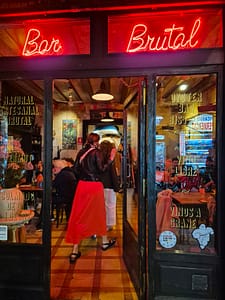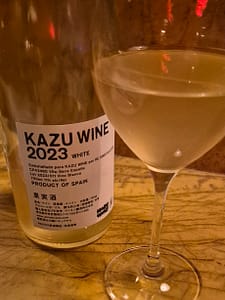A night at Bar Brutal is never just a dinner—it’s a performance. An ever-evolving stage for natural wine, where flavour pairings are exploratory rather than prescriptive, and the sommelier often plays as crucial a role as the chef. On this occasion, guided by the sharp and intuitive Sebastián, I tasted through four wines against three small plates—an informal experiment that revealed unexpected harmonies and tensions.

Bar Brutal, also known as Can Cisa, is one of Barcelona’s pioneering natural wine bars. Opened in 2013 in the El Born district, it was founded by Joan Valencia (of Cuvée 3000) together with Max and Stefano Colombo of Xemei. The focus is on organic and low-intervention wines from Spain and beyond, paired with a lively, Mediterranean-inspired kitchen that highlights seasonal produce.
Kazu 2023 (Umineko Jozo)

From vineyards in Conca de Barberà and Penedès, this wine poured a hazy, pale pinkish-grey—grapefruit juice with a faint golden cast. The nose was floral and citrus-led, with subtle hints of fresh herbs. On the palate, it showed unexpected weight, balanced by clean acidity and a slight phenolic grip. It worked beautifully with zamburiñas—small scallops served with smoky butter and herbs—bringing out a soft sweetness in the shellfish and lending structure without overwhelming the dish.
Jaumet 2023 (Jaume Prats)

From Santa Margalida on Mallorca, made from the red nanto negro, calley and fogoneu, and the white premsal, malvasía and moscatel. Slightly deeper in hue, Jaumet offered aromas of citrus peel and dried orange, with a faint oxidative edge. Its structure was taut and precise, marked by bracing acidity and a long, blood orange finish. It paired brilliantly with mojama—salt-cured tuna—where its sharpness sliced through the dense, iron-rich fish, and the wine’s bitterness mirrored the umami-laden finish of the dish. One of the evening’s most compelling pairings.
Vent Debout 2024 (Domaine Yoyo)

A carignan from Languedoc-Roussillon, direct press, fermented in inox and short time in barriques of 6th use. Clean and pink but bordering on copper, this rosé smelled of raspberry and wild strawberry. Though fruit-driven on the nose, it showed a firm backbone and a savoury streak that came into focus with food. Sebastián confidently recommended it with labneh, and he was right. The creamy, tangy yoghurt seemed made for the wine’s structured acidity. A pairing that felt both precise and generous—like a well-judged chord with just enough tension to be interesting.
Rød 2023 (Bodega Frontio)

Rød, meaning red in Danish, is a garnacha made by Thyge “Chus” Jensen in Arribes. A deep cherry-red wine, Rød was fragrant with red berries—cherry and raspberry—alongside dried herbs and a touch of earth. On the palate, it was fresh and quietly structured, with fine tannins and well-integrated acidity. I had saved a slice of mojama for this wine, and it was a surprisingly successful match. The salt and depth of the tuna played against the wine’s herbal core and supple fruit. With rustic bread and good olive oil, the whole combination felt grounded, unpretentious and complete.

Bar Brutal continues to live up to its name—raw, real, and a little chaotic in the best way. With Sebastián as guide, the wines led the conversation, and the food responded in kind. It was not a menu, but a dialogue—one in which the wines were given room to speak, and where not all pairings needed to resolve. Sometimes, tension is the most expressive note of all.




















